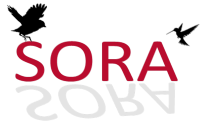An Unusual Sight
An Unusual Sight
What seemed to me a sight worthy of note was observed a few mornings ago on the outskirts of this town. A man was endeavoring to burn the rather green grass on the golf links near the mission during the prevalence of a very strong north wind. While walking along the road, some half mile from the spot, I first observed the smoke rising, and soon noticed that, on the lee side of the fire, the air was dark with what appeared to be swallows, but did not at the moment connect the two incidents in my mind. Approaching from the windward side I ran into a small flight of white-throated swifts (Aeronautes melanoleucus) accompanied by a few Vaux swifts (Chætura vauxi) and a few swallows, and being too near houses to use a large charge, nranaged to drop a couple of the Aeronautes with my 32-cal. auxiliary as they were bucking against the wind. The field was burning just opposite my quarters, and on close approach the air appeared to be actually full of swallows, cliff swallows far outnumbering the other varieties, darting about in the lee of the fire and following the thin smoke for at least a quarter of a mile. All the swallows of the neighborhood seemed to have congregated on the spot. Many were actually flitting through the smoke within three feet of the smouldering blaze where the grass was too green to burn freely, though the heat must have been considerable within such a short distance of the fire.
The burning was not continued for any great length of time on this day, but was resumed on the next when the same occurrence was repeated, the only difference being that the wind being less strong and somewhat shifting the area of the smoke was greater and the birds consequently more scattered. Also on this morning a good many swifts were among the swallows, while on the previous day these had mostly kept to windward of the smoke. On the third day I was busy putting up specimens and did not notice whether there was any fire or not, but in the afternoon Mr. A. P. Redington came to call on me and was much interested at having seen a repetition of this occurrence on the way over, it being something new in his experience.
Neither of us was able to solve the phenomena. We could not ascertain whether the birds were after insects stirred up from the grass, whether they were attracted by the smoke itself, or whether they mistook fine cinders for insects. The first hypothesis seemed untenable from the fact that there could not have been enough insects from such a small area of grass as was burning to amount to much in the way of food for such an assemblage of birds, while the third seems an insult to the birds’ intelligence on account of their persistency in following the smoke for several days. It really appeared as if the smoke itself or the odor therefrom was the great attraction.
JOSEPH MAILLIARD
Santa Barbara, Cal., May 23, 1902.

